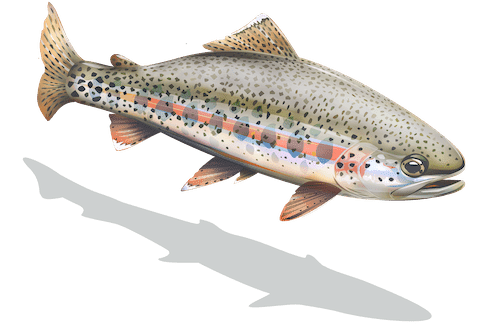How we're working to save them:
Conservation Actions
- Complete and implement the draft Kern River Rainbow Trout Conservation Strategy as soon as possible.
- Use a conservation hatchery to increase numbers of Kern River Rainbow trout and genetic diversity among populations in the wild.
- Review, revise, and implement grazing management to restore ecological function of watersheds.
- Regularly sample populations to determine distribution, abundance, and genetic structure, and to identify any changes in the species’ status.
- Assess, prioritize, and restore riparian and headwater meadows to boost water storage capacity, restore critical habitats, and bolster resiliency to climate change.
Click here to learn about CalTrout’s overall “Return to Resilience” plan to save California’s salmonids from extinction.
Where to find Kern River Rainbow Trout:
Kern River Rainbow Trout Distribution
Historically, Kern River Rainbow trout could be found throughout the Kern River and its tributaries in Tulare County. Today, most populations can only be found far upstream of Lake Isabella within the Sequoia National Forest or Sequoia National Park lands.
How the Kern River Rainbow Trout Scored:


Characteristics
Kern River Rainbow trout look similar to Coastal Rainbow trout, but have a slight gold hint. They have many fine, irregular spots all over their bodies, and larger fish may have a rosy streak along their sides.
Abundance
There are little to no abundance data on unhybridized Kern River Rainbow trout populations. Kern River Rainbow trout were once abundant and widespread in the upper Kern River Basin and were subject to intensive angling pressure. Since the nineteenth century, overexploitation, habitat degradation and, most importantly, hybridization with other trout has reduced populations to a small fraction of historical numbers. Based on CDFW surveys in 2009 and expert judgment, they currently persist in about 20 km (12 mi.) of small streams. Using the best estimates of approximately 200-1,500 trout per km (1.2 mi.), total numbers of Kern River Rainbow trout are likely between 4,000 and 30,000 fish, though are likely at the lower end of this range due to habitat degradation and hybridization. The majority of remaining unhybridized Kern River Rainbows are upstream of natural and/or man-made barriers and isolated from other populations, and their status could deteriorate rapidly due to a lack of population connectivity.
Habitat & Behavior
Almost no life history studies have been conducted on Kern River Rainbow trout. Presumably, they share similar habitat with Coastal Rainbow trout in high elevation streams. They historically grew to large sizes, as much as 71 cm (28 in.) and 3.6 kg (8 lbs.), although fish over 25 cm (10 in.) are rare today. More research is needed on the behaviors and habitat requirements of this rare species.
Genetics
Kern River Rainbow trout are a distinct subspecies of Rainbow trout that likely resulted from natural hybridization of Coastal Rainbow trout with Little Kern Golden trout several thousand years ago. They are most genetically similar to California Golden trout and Little Kern Golden trout than they are to present-day Coastal Rainbow trout.






















 Dams block access to historical spawning and rearing habitats. Downstream, dams alter the timing, frequency, duration, magnitude, and rate of change of flows decreasing habitat quality and survival.
Dams block access to historical spawning and rearing habitats. Downstream, dams alter the timing, frequency, duration, magnitude, and rate of change of flows decreasing habitat quality and survival.